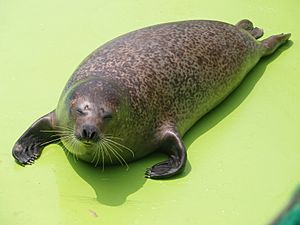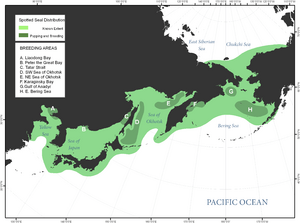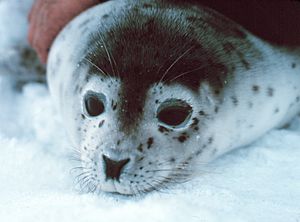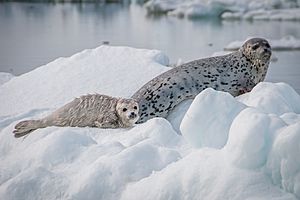Spotted seal facts for kids
Quick facts for kids Spotted seal |
|
|---|---|
 |
|
| In Echizen Matsushima Aquarium, Japan | |
| Conservation status | |
| Scientific classification | |
| Genus: |
Phoca
|
| Species: |
largha
|
 |
|
| Spotted seal distribution | |
The spotted seal (Phoca largha) is also known as the larga seal. It is a type of "true seal" and lives in the cold waters of the northern Pacific Ocean. You can find these seals around ice floes and in seas near the Beaufort Sea, Chukchi Sea, Bering Sea, and Sea of Okhotsk. They also travel south to the northern Yellow Sea and the western Sea of Japan.
Spotted seals are sometimes seen in Alaska, especially from Bristol Bay to Demarcation Point. This happens during summer and autumn when there is no ice, and the seals mate and have their babies. They are very similar to harbor seals, and sometimes they even live in the same areas.
People were worried that spotted seals might become endangered because the ice in the Arctic is melting due to global warming. However, after studying their numbers, experts decided in 2009 that the spotted seal population in Alaska was not in danger.
Contents
What's in a Name?
The scientific name for the spotted seal is Phoca largha. Phoca is a Greek word for seal. Largha comes from the Siberian Tungus people, who used this word for the seal.
The English name "spotted seal" comes from the dark, uneven spots on their fur. In Alaska, different Eskimo groups have their own names for this seal. For example, it's called issuriq in Central Alaskan Yupʼik language and qasigiaq in Inupiaq.
About Spotted Seals
Spotted seals are "true seals," meaning they belong to the Phocidae family. They are a medium-sized seal. Adult spotted seals usually weigh between 180 and 240 pounds (81 to 109 kg). They are about 4.5 to 6.8 feet (1.5 to 2.1 meters) long. This is similar in size to a harbor seal.
Their head is round, and they have a narrow snout that looks a bit like a dog's nose. Spotted seals have a small body and short flippers at the back. These back flippers help them move through the water. Their smaller front flippers act like rudders, helping them steer.
Their fur is thick and can be silver, gray, or white. It has dark, irregular spots all over their body. Male and female spotted seals look very similar in size and shape. They have 34 teeth, just like harbor seals.
Where They Live
Spotted seals live in very cold, arctic or sub-arctic waters. During the time they have their babies, they often stay on the edges of ice floes. They usually avoid very thick, moving ice. In the summer, they might live in the open ocean or on nearby shores.
There are three main groups of spotted seals. One group lives in the Bering Sea. This includes about 100,000 seals near Kamchatka Peninsula in Russia and in Alaskan waters. Another large group, also about 100,000 seals, lives in the Sea of Japan and the Sea of Okhotsk. A smaller group of about 3,300 seals lives further south in Liaodong Bay, China, and Peter the Great Bay, Russia. There is also a very small group of about 300 seals near Baekryeong Isle in South Korea.
Behavior and Life Cycle
Spotted seals are generally shy and don't like to be approached by humans. They usually live alone. However, they gather in large groups when it's time to have their babies or when they are shedding their fur. During these times, they come out of the water onto ice floes or land if there's no ice. In Alaska, thousands of seals can gather in places like Kasegaluk Lagoon.
Spotted seals become old enough to have babies around age four. The breeding season is from January to mid-April. Most babies are born in mid-March. It's believed that spotted seals stay with the same partner each year. During breeding season, they form small "families" with a male, a female, and their baby.
A baby seal is born after about 10 months. Newborn pups are usually about 3 feet (1 meter) long and weigh around 26 pounds. They stop drinking their mother's milk after about six weeks. Spotted seals can live up to 35 years, but most don't live past 25.
When looking for food, spotted seals can dive very deep, sometimes up to 1,000 feet (300 meters). Young seals mostly eat tiny ocean creatures like krill and small crustaceans. Adult seals eat many kinds of fish, such as herring, arctic cod, pollock, and capelin.
Spotted seals don't seem to make many sounds, but we don't know a lot about their vocalizations. They seem to be more vocal when they are in groups shedding their fur. If you get close to these groups, they might make sounds like growls, barks, or roars. Some seals from the Yellow Sea population have been tracked traveling over 3,300 kilometers!
Conservation Status
In 2008, the U.S. National Oceanic and Atmospheric Administration (NOAA) looked into whether the spotted seal should be listed as an endangered species. After an 18-month review, NOAA announced in October 2009 that the two main spotted seal populations in or near Alaska were not in danger of becoming extinct. Even though global warming is causing ice to melt, they don't believe it will affect these seals enough to make them endangered right now.
In South Korea, spotted seals are considered a Natural Monument and a second-class endangered species. This is because seals from South Korea travel to Dalian, China to have their babies. Historically, many seals were hunted there for their skin, which was used in Traditional Chinese medicine. An environmental group called Green Korea United is working with the Chinese government to help protect these seals from being hunted.
See also
 In Spanish: Foca manchada para niños
In Spanish: Foca manchada para niños




